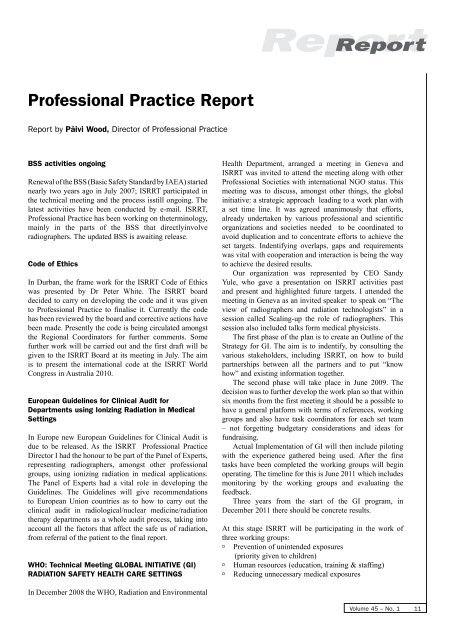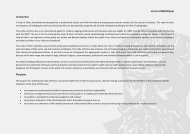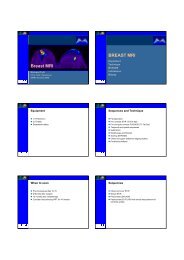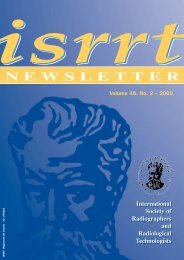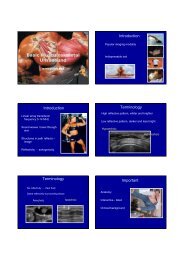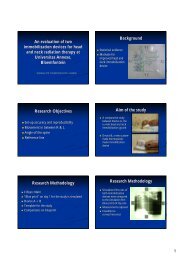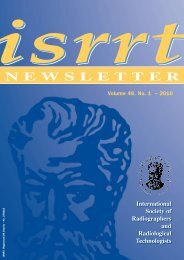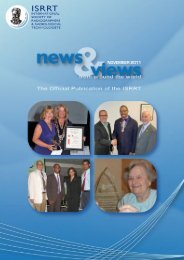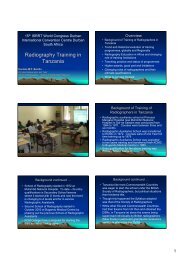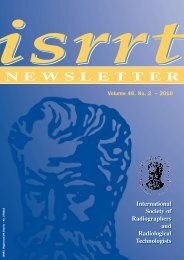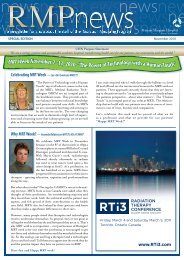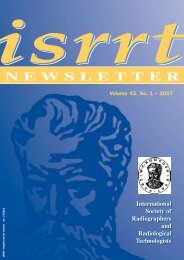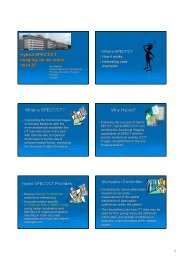images/isrrt/Newsletter May 2009.pdf
images/isrrt/Newsletter May 2009.pdf
images/isrrt/Newsletter May 2009.pdf
You also want an ePaper? Increase the reach of your titles
YUMPU automatically turns print PDFs into web optimized ePapers that Google loves.
ReportProfessional Practice ReportReport by Päivi Wood, Director of Professional PracticeBSS activities ongoingRenewal of the BSS (Basic Safety Standard by IAEA) startednearly two years ago in July 2007; ISRRT participated inthe technical meeting and the process isstill ongoing. Thelatest activities have been conducted by e-mail. ISRRT,Professional Practice has been working on theterminology,mainly in the parts of the BSS that directlyinvolveradiographers. The updated BSS is awaiting release.Code of EthicsIn Durban, the frame work for the ISRRT Code of Ethicswas presented by Dr Peter White. The ISRRT boarddecided to carry on developing the code and it was givento Professional Practice to finalise it. Currently the codehas been reviewed by the board and corrective actions havebeen made. Presently the code is being circulated amongstthe Regional Coordinators for further comments. Somefurther work will be carried out and the first draft will begiven to the ISRRT Board at its meeting in July. The aimis to present the international code at the ISRRT WorldCongress in Australia 2010.European Guidelines for Clinical Audit forDepartments using Ionizing Radiation in MedicalSettingsIn Europe new European Guidelines for Clinical Audit isdue to be released. As the ISRRT Professional PracticeDirector I had the honour to be part of the Panel of Experts,representing radiographers, amongst other professionalgroups, using ionizing radiation in medical applications.The Panel of Experts had a vital role in developing theGuidelines. The Guidelines will give recommendationsto European Union countries as to how to carry out theclinical audit in radiological/nuclear medicine/radiationtherapy departments as a whole audit process, taking intoaccount all the factors that affect the safe us of radiation,from referral of the patient to the final report.WHO: Technical Meeting GLOBAL INITIATIVE (GI)RADIATION SAFETY HEALTH CARE SETTINGSHealth Department, arranged a meeting in Geneva andISRRT was invited to attend the meeting along with otherProfessional Societies with international NGO status. Thismeeting was to discuss, amongst other things, the globalinitiative: a strategic approach leading to a work plan witha set time line. It was agreed unanimously that efforts,already undertaken by various professional and scientificorganizations and societies needed to be coordinated toavoid duplication and to concentrate efforts to achieve theset targets. Indentifying overlaps, gaps and requirementswas vital with cooperation and interaction is being the wayto achieve the desired results.Our organization was represented by CEO SandyYule, who gave a presentation on ISRRT activities pastand present and highlighted future targets. I attended themeeting in Geneva as an invited speaker to speak on “Theview of radiographers and radiation technologists” in asession called Scaling-up the role of radiographers. Thissession also included talks form medical physicists.The first phase of the plan is to create an Outline of theStrategy for GI. The aim is to indentify, by consulting thevarious stakeholders, including ISRRT, on how to buildpartnerships between all the partners and to put “knowhow” and existing information together.The second phase will take place in June 2009. Thedecision was to further develop the work plan so that withinsix months from the first meeting it should be a possible tohave a general platform with terms of references, workinggroups and also have task coordinators for each set team– not forgetting budgetary considerations and ideas forfundraising.Actual Implementation of GI will then include pilotingwith the experience gathered being used. After the firsttasks have been completed the working groups will beginoperating. The timeline for this is June 2011 which includesmonitoring by the working groups and evaluating thefeedback.Three years from the start of the GI program, inDecember 2011 there should be concrete results.At this stage ISRRT will be participating in the work ofthree working groups:˙ Prevention of unintended exposures(priority given to children)˙ Human resources (education, training & staffing)˙ Reducing unnecessary medical exposuresIn December 2008 the WHO, Radiation and EnvironmentalVolume 45 – No. 1 11


